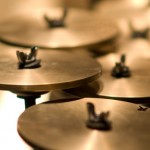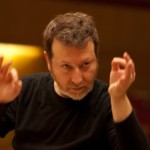Duos—both literal and metaphoric—are the official theme for this year’s Ultraschall Festival for New Music, taking place in Berlin until Jan.31. The event, hosted by the city’s two main classical radio stations, Kulturradio rbb and Deutschlandradio Kultur, is better known for its wide range of offerings than its tight programming. But the concept was not lost on a mostly orchestral concert at the Haus des Rundfunks on Wednesday.
Opening the evening was Jörg Widmann with his own work 5 Bruchstücke (1997) for clarinet and piano. The approximately eight-minute series of miniatures creates pointed dialogue with a range of extended techniques, from circular gestures which are echoed inside the clarinet—so skillful in the hands of Widmann as to simulate live electronic loops—to the strumming of prepared strings. Holger Groschopp, stepping in for Heinz Holliger—who was forced to withdraw for personal reasons—coordinated from the piano with impeccable timing.
In onstage moderation, freshly installed co-intendant and rbb radio host Andreas Göbel extended the duo theme to Widmann’s parallel activities as a clarinettist and composer as well as his use of both A and B clarinets in the Bruchstücke. Widmann admitted that he sometimes “curses” himself in writing such difficult music but considers it an interpreter’s responsibility to test established boundaries.
He then took the stage for Elliott Carter’s Clarinet Concerto (1996). The approximately 18-minute work requires the soloist move about and join different instrumental groups in short episodes until the entire ensemble comes together.
Widmann’s virtuosic execution of the filigree melodies and ability to emerge organically from a range of timbres revealed his uncanny ability to bend the clarinet to his own artistic ends. The conductor Wolfgang Lischke led the Deutsches-Symphonie Orchester in a precise reading whose slightly studied nature can easily be excused given that he was replacing Holliger last-minute.
The second half of the program was devoted to Swiss composers, Holliger the first among them with his double concerto Janus, which premiered in Salzburg two seasons ago. The original soloists, violinist Thomas Zehetmair and violist Ruth Killius, engaged in heated struggle with the orchestra, puncturing a molten surface of swarming textures.
The final stretch of the approximately 20-minute piece, named after the Roman god who looks both to the future and the past, creates tremendous tension with the soloists thrashing their bows in the air, the harpist swiping various plastic objects across her instrument, metallic whirring in the string section giving way to ethereal chimes.
Klaus Huber’s Tenebrae, the only work of the evening to exploit a large-scale orchestra and the oldest on the roster with a premiere date of 1967, is also a study in masterful instrumentation and dramatic purpose. The darkness implied in the title is more of a metaphysical force that drives the music, alternating glassy strings with frenetic winds, eerie emptiness with screaming blasts, a mystic realm that does not seek clear answers. A certain duality nevertheless underpins the 18-minute work.
The 90-year-old Huber was present for a short conversation in which he spoke of the work’s premiere in Warsaw, leading Göbel to tie the theme of darkness to Cold War politics of the time. Yet the composer emphasized that the music should speak for itself, perhaps even more easily now than it did in the 1960s.
![TOM1848[1]](http://www.musicalamerica.com/mablogs/wp-content/uploads/2014/01/TOM18481.jpg)

